AIRLINE OVERRUN WARNING AND PROTECTION SYSTEMS
One of the main concerns with airline safety is the use of automated systems versus manual operations. To some degree the modern pilot has to be a manager of technology systems, but at the same time be able to carry out manual tasks as and when required. This involves knowing when to monitor systems and when to be an active operator within the larger system. Both, technology and the human performer have the same focus in respect to increasing safety in all aspects of flight if they are well designed. However due to a lack of situational awareness or high stress levels, it is not uncommon for a pilot to be presented with a situation where they may apply inaccurate logic requiring alternative solutions. By far the most crucial phase of flight are the take off and landing phases and as such the current technology has provided some assurances of increasing safety during these phases. Automated processes are designed to reduce pilot/crew workload and provide essential information for these crucial phases. The area of concern here is the landing phase, or to be more specific avoiding the potential of over running the runway.
I have provided a couple of links to videos that exemplify the importance of this phase of flight and the potential for disastrous consequences.
The first is an animated simulation of an actual runway overrun occurrence.
NTSB Animation Runway Overrun of Southwest Airlines Flight 1248 at Chicago Midway
http://www.youtube.com/watch?v=9B_f8XNThcA&feature=fvsr
The second is also an animated simulation of a real event, however does contain actual footage of the ‘end result‘.
Air France 358 "Toronto Overrun
http://www.youtube.com/watch?v=6JhoVbX6Xsw
Both videos serve to show how a lapse in pilot concentration or inability to read a situation correctly may result in a potentially devastating situation.
According to figures “a quarter of all incidents and accidents in air transport operations are runway excursion events, a figure that rises to 96% if only runway accidents are considered.” (Interpilot, 2009) The old saying ‘prevention is better than cure’ has been used to describe the debate as to whether (the cure) a standard 300m runway extension known as the ‘runway end safety area’ (RESA), (image provide below) should be put in place as recommended by ICAO, (which incidentally may not be possible at some airports due space constraints or availability of planning consent.) Alternatively, further research and development of existing technologies offers a preventative strategy to tackle this problem. (prevention mechanism)
RESA/EMAS

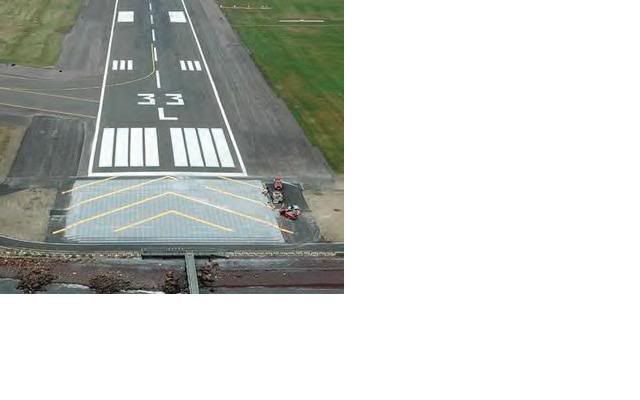
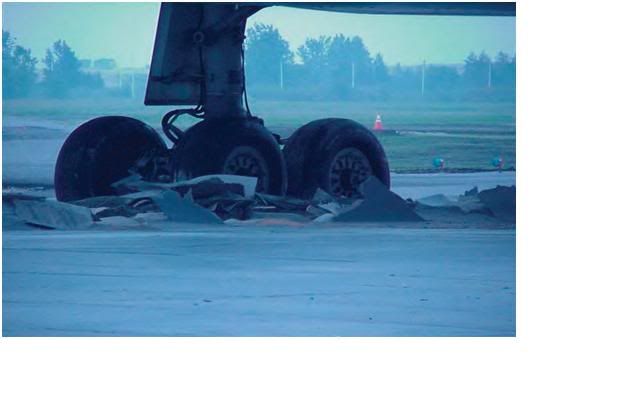
Statistics provide a strong case to support the use of RESAs. "For example, in 2005 alone there were over 44 runway overrun accidents worldwide." (N'Formation Line Up, 2009) The EMAS system is "designed to arrest aircraft at runway exit speeds of around 70 knots and to completely stop aircraft before reaching natural or man-made hazards (e.g. steep terrain, bodies of water, highways, railroads, or populated areas)." (N'Formation Line Up, 2009)
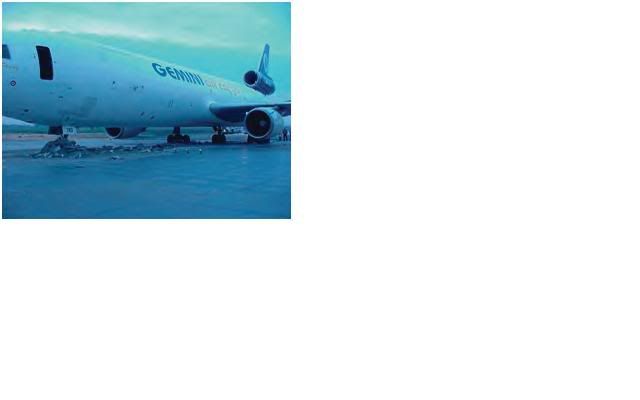
In response to this airbus have developed a system to protect or rather decrease the chances of such excursions happening. It is aptly known as the (ROW) Runway Overrun Warning/Runway Overrun Protection (ROP) system. A diagrammatical representation of how this function operates is provided below.
ROW/ROP
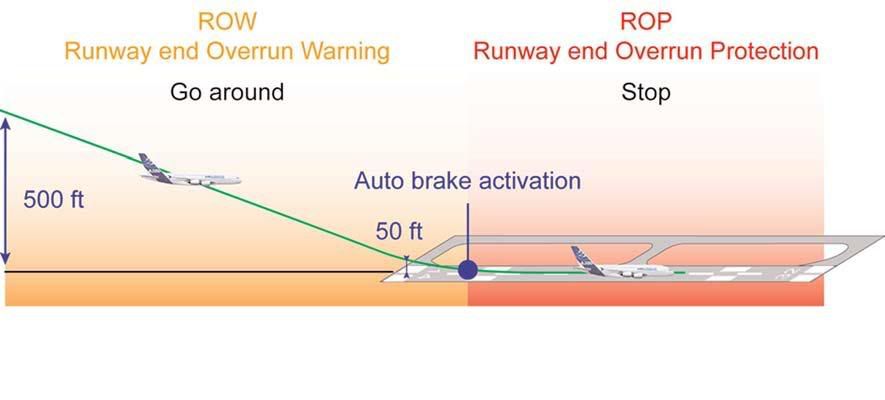
To address this problem, experts in the field have suggested that “in order to develop an effective counter strategy to overruns, you must first consider the reasons why they occur.” (InterPilot, 2009) These have been identified as the following;
- Approach unstable below 1,000/500ft
- Windshift or shear at low altitude
- Approach becoming unstable at low altitude
- Long flare
- Long de-rotation
- Late selection of reverse thrust
- Autobrake setting too low
- Late or weak manual braking
- Cancellation of reverse thrust at 70kts
- System failure affecting landing distance
- Contaminated runway
It can be seen from the above list that it would be difficult to precisely predict the landing phase due to the matrix of contributory factors affecting a landing. Thus the pilot/crew workload is high and as such could be prone to making errors of judgement. Hence it would seem beneficial to develop an automated “system that would help crews to anticipate and recognise elevated overrun risk.” (InterPilot, 2009) This is precisely what the ROW/ROP system does by comparing aircraft breaking capability against landing distance available. (LDA) In the event that the automated system predicts an occurrence or runway overrun, it will use visual and aural warnings to alert the crew. Ie. Display and aurally repeat the words “RUNWAY TOO SHORT”. “Naturally, these warnings should, in the first case, heighten crew awareness of the potential for overrun and, in the second, prompt a go-around. The key element is that the system is dynamic and will react to rapidly changing elements that may alter the aircraft approach path or speed.” (InterPilot, 2009)
Below is picture of the actual display as seen by the pilot.
ROW/ROP VISUAL DISPLAY
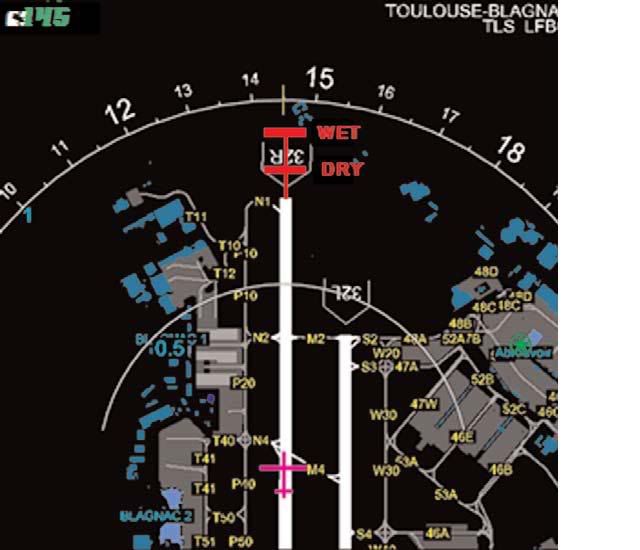
In the event that the aircraft approach path means that the DRY stop line moves beyond the LDA then the track line changes to red and a red “RWY TOO SHORT visual cue is displayed on the PFD combined with a “RUNWAY TOO SHORT” aural cue. (InterPilot, 2009)
A major issue with pilot training is that as a pilot there is a natural instinct to revert to a pre-programmed response in the event of an unexpected situation arising. Following standard operating procedures (SOP’s) during non-standard situations is basically applying the wrong solution to a problem and as such can compound an already difficult situation. For example, it has been suggested that “In a number of overrun incidents research revealed that, despite the poor deceleration and the rapidly approaching end of the runway, crews have on reaching 80kts either cancelled or reduced reverse thrust to idle in accordance with standard procedures rather than accepting that they are being presented with a non standard situation – an understandable scenario given the stress involved and the human tendency to revert to trained responses when under duress.” (InterPilot, 2009) However, with the assistance of such automated systems it will reduce the likelihood of a pilot applying incorrect (ADM) aeronautical decision making. For instance, the ROP system takes into account landing speed versus distance available and accordingly “as aircraft velocity reaches 80kts the aural cue “KEEP MAX REVERSE” is triggered and this cue too will repeat at any time reverse is not at maximum.” (InterPilot, 2009)
The system has been well received by the airlines and as of September 2006 the system had been tested, consequently Air France and Lufthansa are now using the system on their A380s. It is expected that the system will be certified for all A380’s in the near future. It is also of the opinion of IFALPA that “Airbus have created a system which will inevitably, become a life saving addition to the safety system.” (InterPilot, 2009)
For further information on this subject please refer to the following link below
The main source of information for this subject was from an article in the InterPilot journal
Want to know more?
Follow the attached link where you will find the complete article "A major contribution to aviation safety – the Airbus Runway Overrun Warning & Protection System" It gives full details of how the system operates with statistics of system test to back up operational effectiveness of the system
http://www.ifalpa.org/downloads/Level1/Interpilot/2009/10NWS02_Interpilot_July_Aug_2009.pdf
Also for further information on EMAS: Engineered Material Arrestor System A RESA Solution use the following link
http://www.nzalpa.org.nz/LinkClick.aspx?fileticket=CAT0mGbtSUw%3d&tabid=128&mid=539









